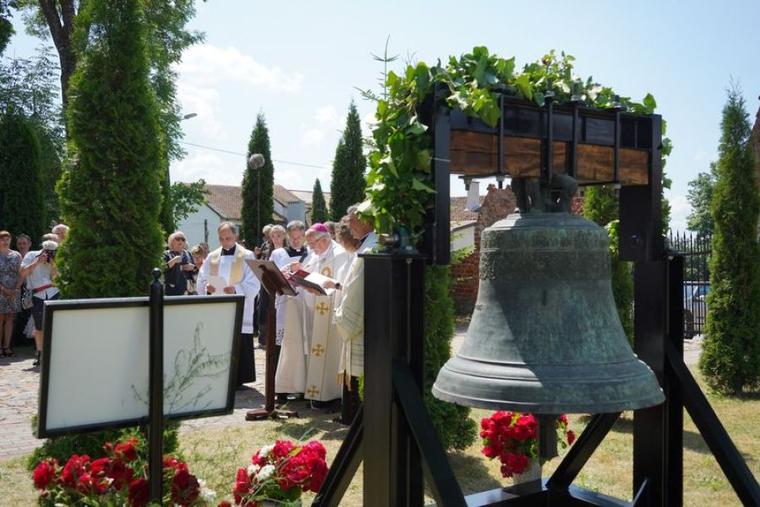- Feb 5, 2002
- 166,654
- 56,276
- Country
- United States
- Faith
- Catholic
- Marital Status
- Married
- Politics
- US-Others
At a service marking the return of the bells, Bishop Jacek Jezierski of the Diocese of Elbląg reflected on the historic and symbolic significance of the bells.
This past weekend, a German bishop and a German state premier took part in an initiative to bring bells stolen by the Nazis during World War II to their rightful homes in Poland.
Bishop Gebhard Fürst of the Diocese of Rottenburg-Stuttgart and Baden-Württemberg’s premier, Winfried Kretschmann, completed the act of repatriation, which spanned three different locations within Poland, according to CNA Deutsch, CNA’s German-language partner agency.
The church bells were originally taken from the communities of Straszewo (formerly Dietrichsdorf), Frombork (Frauenburg), and Zegoty (Siegfriedswalde), CNA Deutsch reported. Postwar, they found their way into Catholic churches in Württemberg, Germany. On the weekend of June 24-25, they made their long-awaited return journey, restoring an essential part of these communities’ Catholic heritage.
The repatriation of the church bells is part of a larger initiative, “Bells of Peace for Europe,” initiated by Bishop Fürst. The project was inspired by renovations at the St. Martin Cathedral in Rottenburg, which revealed that one of the cathedral's bells originally hailed from what is modern-day Poland. An in-depth investigation of all Catholic churches in Württemberg further uncovered 66 additional bells from the same era, with 54 of them still active, according to the diocese.
At a service marking the return of the bells, Bishop Jacek Jezierski of the Diocese of Elbląg reflected on the historic and symbolic significance of the bells: “The bell bore witness to a difficult history but also to peace and hope.”
The Polish prelate also expressed gratitude to his German counterpart for initiating this project. In response, Bishop Fürst said: “The bell has experienced and helped shape the shared history of both nations.”
The bells, once symbols of conflict and dispossession, are now symbols of unity and reconciliation between Germany and Poland, both sides affirmed.
Among the bells returned through the “Peace Bells for Europe” project was one that Bishop Fürst personally blessed in Żegoty following a traditional Sacred Heart devotion. This bell had been earmarked by the Nazis for the armaments industry during World War II but had evaded melting down.
Continued below.

 www.ncregister.com
www.ncregister.com
This past weekend, a German bishop and a German state premier took part in an initiative to bring bells stolen by the Nazis during World War II to their rightful homes in Poland.
Bishop Gebhard Fürst of the Diocese of Rottenburg-Stuttgart and Baden-Württemberg’s premier, Winfried Kretschmann, completed the act of repatriation, which spanned three different locations within Poland, according to CNA Deutsch, CNA’s German-language partner agency.
The church bells were originally taken from the communities of Straszewo (formerly Dietrichsdorf), Frombork (Frauenburg), and Zegoty (Siegfriedswalde), CNA Deutsch reported. Postwar, they found their way into Catholic churches in Württemberg, Germany. On the weekend of June 24-25, they made their long-awaited return journey, restoring an essential part of these communities’ Catholic heritage.
The repatriation of the church bells is part of a larger initiative, “Bells of Peace for Europe,” initiated by Bishop Fürst. The project was inspired by renovations at the St. Martin Cathedral in Rottenburg, which revealed that one of the cathedral's bells originally hailed from what is modern-day Poland. An in-depth investigation of all Catholic churches in Württemberg further uncovered 66 additional bells from the same era, with 54 of them still active, according to the diocese.
At a service marking the return of the bells, Bishop Jacek Jezierski of the Diocese of Elbląg reflected on the historic and symbolic significance of the bells: “The bell bore witness to a difficult history but also to peace and hope.”
The Polish prelate also expressed gratitude to his German counterpart for initiating this project. In response, Bishop Fürst said: “The bell has experienced and helped shape the shared history of both nations.”
The bells, once symbols of conflict and dispossession, are now symbols of unity and reconciliation between Germany and Poland, both sides affirmed.
Among the bells returned through the “Peace Bells for Europe” project was one that Bishop Fürst personally blessed in Żegoty following a traditional Sacred Heart devotion. This bell had been earmarked by the Nazis for the armaments industry during World War II but had evaded melting down.
Continued below.

Ringing in a New Era: the Historic Return of Nazi-Plundered Bells to Poland
At a service marking the return of the bells, Bishop Jacek Jezierski of the Diocese of Elbląg reflected on the historic and symbolic significance of the bells.
